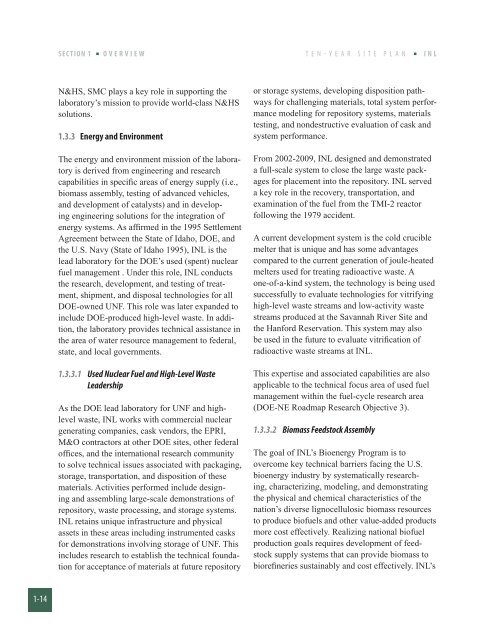2013-2022 TEN-YEAR SITE PLAN - Idaho National Laboratory
2013-2022 TEN-YEAR SITE PLAN - Idaho National Laboratory
2013-2022 TEN-YEAR SITE PLAN - Idaho National Laboratory
You also want an ePaper? Increase the reach of your titles
YUMPU automatically turns print PDFs into web optimized ePapers that Google loves.
1-14<br />
SECTION 1 OVERVIEW<br />
N&HS, SMC plays a key role in supporting the<br />
laboratory’s mission to provide world-class N&HS<br />
solutions.<br />
1.3.3 Energy and Environment<br />
The energy and environment mission of the laboratory<br />
is derived from engineering and research<br />
capabilities in specific areas of energy supply (i.e.,<br />
biomass assembly, testing of advanced vehicles,<br />
and development of catalysts) and in developing<br />
engineering solutions for the integration of<br />
energy systems. As affirmed in the 1995 Settlement<br />
Agreement between the State of <strong>Idaho</strong>, DOE, and<br />
the U.S. Navy (State of <strong>Idaho</strong> 1995), INL is the<br />
lead laboratory for the DOE’s used (spent) nuclear<br />
fuel management . Under this role, INL conducts<br />
the research, development, and testing of treatment,<br />
shipment, and disposal technologies for all<br />
DOE-owned UNF. This role was later expanded to<br />
include DOE-produced high-level waste. In addition,<br />
the laboratory provides technical assistance in<br />
the area of water resource management to federal,<br />
state, and local governments.<br />
1.3.3.1 Used Nuclear Fuel and High-Level Waste<br />
Leadership<br />
As the DOE lead laboratory for UNF and highlevel<br />
waste, INL works with commercial nuclear<br />
generating companies, cask vendors, the EPRI,<br />
M&O contractors at other DOE sites, other federal<br />
offices, and the international research community<br />
to solve technical issues associated with packaging,<br />
storage, transportation, and disposition of these<br />
materials. Activities performed include designing<br />
and assembling large-scale demonstrations of<br />
repository, waste processing, and storage systems.<br />
INL retains unique infrastructure and physical<br />
assets in these areas including instrumented casks<br />
for demonstrations involving storage of UNF. This<br />
includes research to establish the technical foundation<br />
for acceptance of materials at future repository<br />
T E N - Y E A R S I T E P L A N INL<br />
or storage systems, developing disposition pathways<br />
for challenging materials, total system performance<br />
modeling for repository systems, materials<br />
testing, and nondestructive evaluation of cask and<br />
system performance.<br />
From 2002-2009, INL designed and demonstrated<br />
a full-scale system to close the large waste packages<br />
for placement into the repository. INL served<br />
a key role in the recovery, transportation, and<br />
examination of the fuel from the TMI-2 reactor<br />
following the 1979 accident.<br />
A current development system is the cold crucible<br />
melter that is unique and has some advantages<br />
compared to the current generation of joule-heated<br />
melters used for treating radioactive waste. A<br />
one-of-a-kind system, the technology is being used<br />
successfully to evaluate technologies for vitrifying<br />
high-level waste streams and low-activity waste<br />
streams produced at the Savannah River Site and<br />
the Hanford Reservation. This system may also<br />
be used in the future to evaluate vitrification of<br />
radioactive waste streams at INL.<br />
This expertise and associated capabilities are also<br />
applicable to the technical focus area of used fuel<br />
management within the fuel-cycle research area<br />
(DOE-NE Roadmap Research Objective 3).<br />
1.3.3.2 Biomass Feedstock Assembly<br />
The goal of INL’s Bioenergy Program is to<br />
overcome key technical barriers facing the U.S.<br />
bioenergy industry by systematically researching,<br />
characterizing, modeling, and demonstrating<br />
the physical and chemical characteristics of the<br />
nation’s diverse lignocellulosic biomass resources<br />
to produce biofuels and other value-added products<br />
more cost effectively. Realizing national biofuel<br />
production goals requires development of feedstock<br />
supply systems that can provide biomass to<br />
biorefineries sustainably and cost effectively. INL’s

















